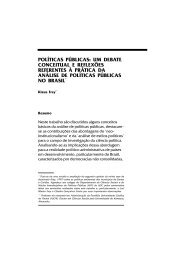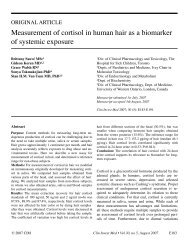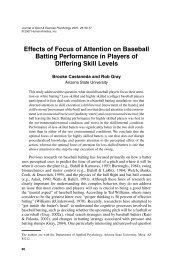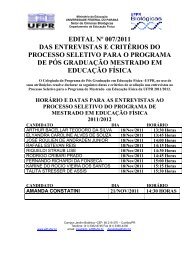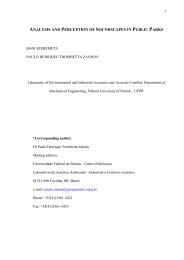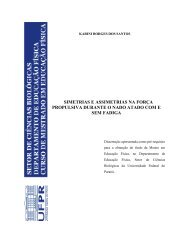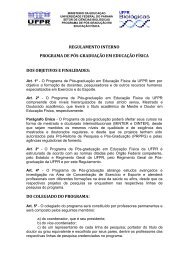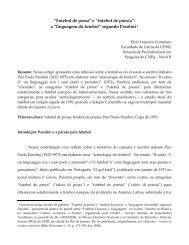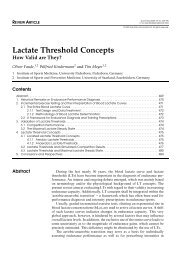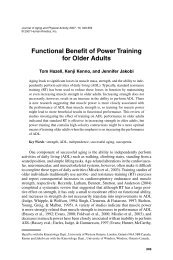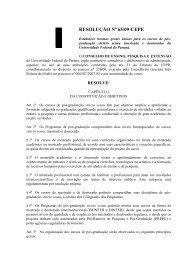Journal of Electromyography and Kinesiology - UFPR
Journal of Electromyography and Kinesiology - UFPR
Journal of Electromyography and Kinesiology - UFPR
Create successful ePaper yourself
Turn your PDF publications into a flip-book with our unique Google optimized e-Paper software.
D.P. LaRoche et al. / <strong>Journal</strong> <strong>of</strong> <strong>Electromyography</strong> <strong>and</strong> <strong>Kinesiology</strong> 20 (2010) 482–488 483<br />
1998). This results in older fallers demonstrating a slowed reaction<br />
to postural disturbances resulting in the need for greater muscular<br />
forces during recovery (Sieri <strong>and</strong> Beretta, 2004; van den Bogert<br />
et al., 2002; Kemoun et al., 2002; Thelen et al., 1997, 2000).<br />
Ambiguity in the literature exists as to which muscle groups<br />
have the greatest loss <strong>of</strong> function <strong>and</strong> which neuromuscular performance<br />
variables are most affected in fallers. Therefore the purpose<br />
<strong>of</strong> this study was to determine how timing <strong>of</strong> muscle<br />
activation, nervous drive to the muscle, <strong>and</strong> muscle strength are<br />
related to a history <strong>of</strong> falls making comparisons across the knee<br />
flexors, knee extensors, ankle plantarflexors <strong>and</strong> dorsiflexors. The<br />
researchers hypothesized that fallers would have slower muscle<br />
activation times, lower strength <strong>and</strong> rate <strong>of</strong> torque development,<br />
<strong>and</strong> reduced nervous drive to the muscle, <strong>and</strong> that these deficits<br />
would be greatest in the rarely trained ankle dorsiflexors. Moreover,<br />
we aim to identify those muscles groups most in need <strong>of</strong><br />
exercise in the elderly <strong>and</strong> to highlight which aspects <strong>of</strong> neuromuscular<br />
performance are mostly impaired in elderly fallers.<br />
2. Methods<br />
2.1. Subjects<br />
A total <strong>of</strong> 23 women aged 65–85 years participated in this<br />
experiment. There were no significant differences between fallers<br />
<strong>and</strong> nonfallers for age, height, mass, BMI or the reported volume<br />
<strong>of</strong> physical activity (see Table 1). The women were categorized as<br />
fallers <strong>and</strong> nonfallers based on the protocol used by Skelton et al.<br />
(2002), <strong>and</strong> were then age-matched across groups. Fallers were defined<br />
as women who had fallen, or nearly fallen but caught themselves<br />
with their upper body, three or more times within the last<br />
year <strong>and</strong> nonfallers had no history <strong>of</strong> unexplained falls. Participants<br />
were independent women capable <strong>of</strong> ambulating without<br />
assistive devices <strong>and</strong> had no known neurological or muscular disorders.<br />
Volunteers were excluded from the study if they had any <strong>of</strong><br />
Table 1<br />
Subject descriptive characteristics.<br />
Fallers<br />
n =11<br />
Nonfallers<br />
n =12<br />
P-value<br />
Age (year) 71.3 ± 5.4 71.2 ± 6.2 0.500<br />
Mass (kg) 73.7 ± 17.6 65.1 ± 12.4 0.163<br />
Height (cm) 163.1 ± 6.2 160.5 ± 6.7 0.203<br />
Body mass index (kg m 2 ) 27.6 ± 5.7 25.2 ± 4.1 0.178<br />
Activity (METs h week 1 ) 27.9 ± 22.2 29.6 ± 31.5 0.379<br />
the following conditions: severe arthritis, severe osteoporosis,<br />
uncontrolled blood pressure over 160/90 mm Hg, neurological disorders,<br />
knee or hip replacement in the dominant leg, <strong>and</strong> evidence<br />
<strong>of</strong> severe heart disease or dysrhythmia. All volunteers were required<br />
to provide written consent from their physician prior to<br />
participation <strong>and</strong> gave their own written informed consent. The<br />
protocol was approved by the University’s Institutional Review<br />
Board for the use <strong>of</strong> human subjects.<br />
2.2. Procedures<br />
Subjects reported to the laboratory on two separate days. The<br />
first visit was reserved for completion <strong>of</strong> interviews, assessment<br />
<strong>of</strong> leg dominance, familiarization <strong>of</strong> equipment <strong>and</strong> experimental<br />
procedures, <strong>and</strong> for recording age, height, mass, <strong>and</strong> body mass index<br />
(BMI). Interviews were conducted to obtain fall history, assess<br />
fall risk factors, <strong>and</strong> determine the volume <strong>of</strong> physical activity performed<br />
over the previous ten years. A fall risk assessment questionnaire<br />
(Table 2) was developed using the ‘‘Guideline for the<br />
Prevention <strong>of</strong> Falls in Older Persons” by the American Geriatrics<br />
Society, British Geriatrics Society, <strong>and</strong> American Academy <strong>of</strong><br />
Orthopedic Surgeons Panel on Falls Prevention (AGS, 2001). This<br />
questionnaire identified factors most closely associated with falls.<br />
Physical activity volume over the previous ten years was estimated<br />
according to the methods <strong>of</strong> Kriska et al. (1990) using published<br />
energy costs for common physical activities (Ainsworth et al.,<br />
1993).<br />
A second visit was scheduled approximately seven days later<br />
<strong>and</strong> included assessments <strong>of</strong> premotor time, motor time, total reaction<br />
time, peak joint torque, time to peak torque, rate <strong>of</strong> torque<br />
development, impulse, the magnitude <strong>of</strong> nervous stimulation <strong>of</strong><br />
the agonists, <strong>and</strong> antagonist coactivation in a visually cued reaction<br />
task. These measures were obtained during maximal voluntary<br />
isometric contractions (MVC) <strong>of</strong> the dominant limb <strong>and</strong><br />
were performed separately for the knee flexors (KF), knee extensors<br />
(KE), ankle plantarflexors (PF) <strong>and</strong> ankle dorsiflexors (DF).<br />
The investigators measured isometric strength as opposed to dynamic<br />
strength so that the time domain variables (premotor time,<br />
motor time, reaction time, time to peak torque, rate <strong>of</strong> torque<br />
development, <strong>and</strong> impulse) would not be influenced by movement<br />
<strong>of</strong> the resistance arm or changes in the length–tension relationship<br />
<strong>of</strong> the muscle during shortening. All measurements were completed<br />
using a HUMAC Norm dynamometer (CSMI, Stoughton,<br />
MA, USA) integrated with a BIOPAC MP100 data acquisition system<br />
that recorded joint torques from the analog output <strong>of</strong> the dynamometer.<br />
Prior to each data collection, the dynamometer was calibrated<br />
according to the manufacturer’s recommendations. Torque<br />
Table 2<br />
Results <strong>of</strong> a questionnaire developed to assess the prevalence <strong>of</strong> factors associated with increased fall risk.<br />
Fallers (% responding yes) Nonfallers (% responding yes) P-value<br />
Do you ever feel dizzy after getting up from a seated or lying down position? 27 0 0.029 *<br />
Do you ever feel dizzy for no apparent reason? 36 8 0.055<br />
Do you take medications for depression, anxiety, seizure prevention or as a sleep aid? 45 8 0.024 *<br />
Do you take two or more medications (excluding vitamins <strong>and</strong> supplements)? 73 42 0.071<br />
Do you have Diabetes? 9 0 0.148<br />
Do you suffer from high levels <strong>of</strong> stress or depression? 27 0 0.029 *<br />
Do you wear visual aids? 100 100 0.50<br />
Do you have trouble sleeping which results in not enough sleep? 64 8 0.004 *<br />
Do you have arthritis in the spine or lower limbs? 82 25 0.004 *<br />
Have you been diagnosed with osteoporosis? 18 17 0.463<br />
Do you have chronic muscle pain in the torso or lower limbs? 27 0 0.029 *<br />
Do you have difficulty walking or use a gait aid to help you walk? 0 0 0.500<br />
Do you have trouble getting up out <strong>of</strong> a chair or getting up when you are lying down? 18 0 0.066<br />
Do you tire easily when you walk on a flat surface? 27 0 0.029 *<br />
* P 6 0.05.



